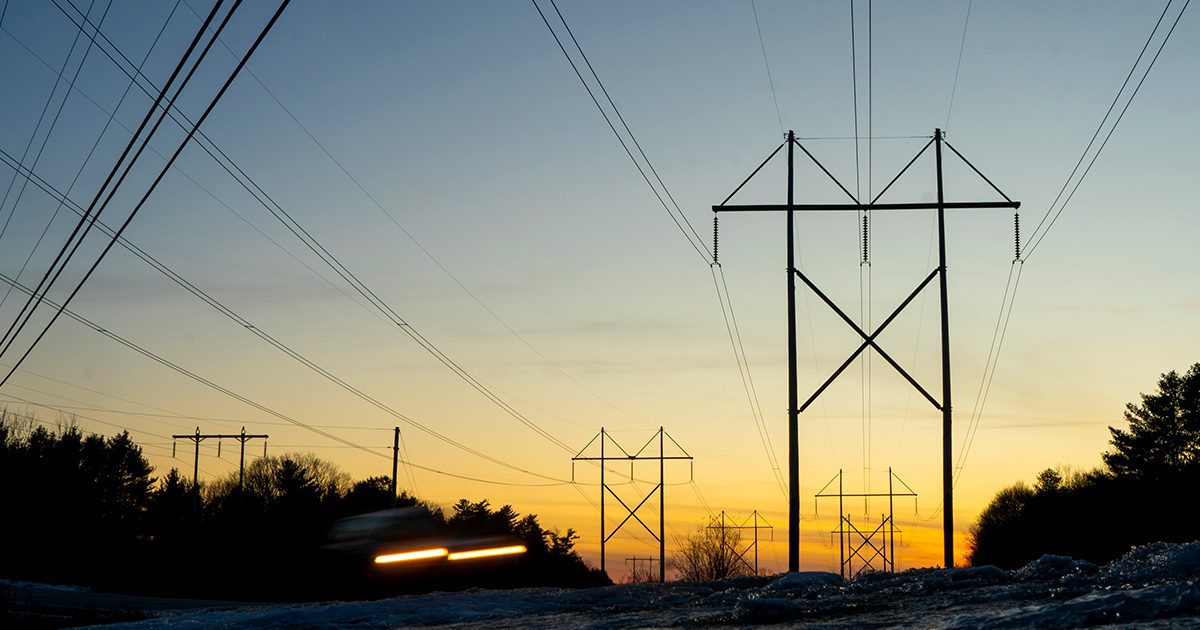Maine’s transition to clean energy hinges on a wholesale transformation of the electrical grid. Several laws passed in recent years may improve grid planning, but legislating institutional change in the utility field could prove challenging.
A recent decision by the Maine Public Utilities Commission (PUC) points up how investor-owned utilities still steer the grid-planning process and how often they operate with clear conflicts of interest and a fuzzy understanding of their own systems. That’s a big problem since the PUC often defers to the presumed expertise of utilities in its decision-making.
In this instance, Central Maine Power requested permission to rebuild the Section 80 transmission line serving the Midcoast at a cost to New England ratepayers of $63.6 million. Now about 32 feet high, the transmission towers would increase to around 80 feet along a 22-mile corridor running from Winthrop to Warren.
For the first time ever in this case, ratepayers had two other state entities, armed with data from a third-party expert, advocating on their behalf. In a compelling written argument (see item 438), the Maine Office of the Public Advocate (OPA) and Efficiency Maine Trust claimed that the PUC’s preliminary justification for its decision “mischaracterizes the factual record” because it relies on “CMP’s outdated and undocumented assertions about the facts underlying the projected need for the Section 80 Rebuild.”
They further argued that “overbuilding” transmission lines “is the most expensive way to respond to perceived but unknown needs and should not be approved here based on the scant CMP factual record before the Commission.” They advocated that the PUC defer a decision and seek a more thorough analysis from New England grid operators.
Their advocacy made this case more visible, generating an unusual degree of public comment. Nearly 400 residents (myself included) weighed in to express concerns about the enlarged transmission line.
The Commission acknowledged the input and then voted to grant CMP’s rebuild request.
First established in 1914, the PUC has been operating in much the same manner for a very long time. Like the grid itself, the Commission needs an overhaul.
For that institutional change to occur, more Maine residents need to understand what happens in the arcane world of PUC deliberations. Welcome to case number 2011-00138, the first test of Maine’s 2019 “Non Wires Alternatives” (NWA) Act.
Understanding the significance of non wires alternatives
While more or larger transmission lines are sometimes needed to modernize the grid, in many cases the most cost- and climate-conscious choice does not involve more wires, concrete or steel. Much of the electricity Maine will need to get vehicles and heating systems off fossil fuels will come from distributed energy resources (DER, in utility lingo), which can include new generation (like and wind and solar systems), battery storage and “demand response,” managing the load on the grid by providing rate incentives for consumers to use energy at off-peak times.
“In an ideal world, a lot of innovation could happen at the edge of the grid — in generation, storage, and demand response. The utility could be an active participant, moving us toward cleaner, cheaper options,” observed Seth Berry, a long-time co-chair of the Legislature’s Energy, Utilities and Technology committee, who stepped down in June to devote more time to Maine’s Our Power campaign for a consumer-owned utility.
In the real world, investor-owned utilities typically ignore distributed energy resources because their profits derive primarily from a rate of return pre-established with state utility commissions (typically upward of 9 percent) on investments made in new infrastructure. Put simply, they have a vested interest in overbuilding the grid.
To counter that, the law charged the public advocate’s office with overseeing work by an expert to assess costs and benefits for each planned infrastructure project, determining whether ratepayers would be better served by distributed energy resources rather than more and bigger power lines.
The non wires alternatives legislation is a small step toward remedying the huge “asymmetry of resources” built into the system, Berry noted, in which utilities have far more legal and financial resources and more grid information than regulators or advocates. By establishing an outside review, the law makes regulators somewhat less beholden to utilities for data.
The Maine OPA hired an international engineering firm with a strong background as electrical system planning experts, and it has proven “incredibly competent at the technical side of [this process],” said Andrew Landry, OPA’s deputy director. With funding covered by Maine ratepayers, the firm undertook the sort of expert analysis that the PUC cannot do in-house.
It concluded in this case that DER options, such as new solar farms and demand response, could meet future demands without a transmission line rebuild. Efficiency Maine, which Landry said plays a “very important role… [providing] supporting analysis and recommended solutions on the customer side of the meter,” agreed.
Why did an improved process still lead to a poor outcome?
Just as the law had intended, the PUC had far more complete information on which to base its decision, with an outside technical review and greater public input.
But none of that changed the Commission’s decision. This might not bode well for recent laws intended to ensure that the PUC factors climate and equity considerations into its decisions and oversees the grid-planning work of utilities. These measures do not have the built-in oversight mechanisms of the NWA Act, which could make their prospects for influencing PUC decision-making even slimmer.
Staff at the public advocate’s office took several lessons from this frustrating initial test case. For more collaborative outcomes, Landry said, the expert NWA Coordinator will need to “have access to [utilities’] planning at a much earlier stage” and utilities will need “to have extremely clear planning standards” identified at the outset. In this instance, he said, CMP was “frequently adding new planning standards that our alternative would have to satisfy.”
The OPA found a shocking lack of data underlying CMP’s transmission line rebuild request. “I don’t know how they do planning,” Landry said. “It doesn’t appear they have enough data about their system, particularly at the distribution level, to analyze system needs.”
Advocates of grid reform, while disappointed with the Commission’s decision, express gratitude for the active role the OPA and Efficiency Maine took. With a new public advocate who knows utilities well, Berry said, the office “has the capacity to do some historic good serving the people of Maine and our energy future.”
Jeff Marks, a senior policy advocate with the nonprofit Acadia Center, said he’s hopeful that the combined impact of recent laws “will force the PUC to look at things more closely and come to different decisions.” Just days ago, the PUC did approve a non-wires solution in the second test case under the new law, eliminating the need to rebuild the Section 31 transmission line in Topsham, a smaller and less costly project than Section 80. The settlement that the public advocate negotiated with CMP in that case is expected to save ratepayers an estimated $8.5 million over time and provide additional consumer benefits like energy-efficiency savings.
Going forward, more citizens and advocacy groups will need to scrutinize the regulatory process to ensure that the needs of ratepayers, climate and equity receive fair consideration. Until significant change occurs in the grid-planning process or utility business model, Marks noted, “we need to hold the PUC’s feet to the fire.”








